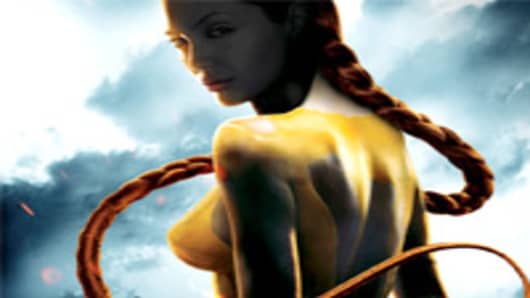The reviews for the new blockbuster-in-the-making "Beowulf," released today, have been pretty good these last few days, but when it comes to the ground-breaking technology used to make the film, the reaction has been nothing short of overwhelming.
And if you haven't had a chance to see these effects, and you appreciate the power of the computer in filmmaking nowadays, you gotta check this out.
Sure, it's 3-D (though few theaters are equipped to show it like that), and there's an IMAX version of the film, which I have yet to see but can only imagine how breathtaking it must be. That's because the effects used to make the movie border on jaw-dropping. That line between what is real and what is not, what was "shot" and what was "rendered" has been blurred like it's never been blurred before. And that's the only blurry thing in the movie.
And the movie is already generating interest in where the effects go from here. With a lot of focus on long-time Silicon Valley entrepreneur Steve Perlman. You might remember Perlman from his role as WebTV's co-founder, or as the driving force behind the Moxi media center.
But for the past few years, he's been running Rearden Companies in San Francisco, an incubator of new technologies, including his company Mova which is trying to break new ground in the world of motion capture. I had a chance to play with Mova's technology at the Computer Games Developer Conference earlier this year in San Francisco and it was a knock-your-socks off kind of technology.
There was early word that the effects in Beowulf came courtesy of a company under Perlman's control. True, filmmakers used Perlman's "Ice Blink" for art and production design. But the heavy lifting on those remarkable effects came from Sony ImageWorks and a company called Vicon and its marker-based capture system.
Yet as good as Vicon is, capturing several hundred "markers" on Angelina Jolie's face and body, experts say Perlman's newer "Contour" system captures hundreds of thousands of points. Some in Hollywood are calling this the key breakthrough that will create "photo-realistic" animated characters.
Critics are already talking about not being able to tell where the real actor's performance ends and the computer generated imagery begins. Artists have long been using 3-d "casts" to sculpt different effects, but Mova's Contour relies on a battery of cool software and powerful computers to get the job done. The first film's based on Mova's Contour are expected out some time in 2008.
There's speculation that George Lucas is either working on a similar kind of technology for his upcoming animated weekly TV series "Clone Wars" coming some time next year, or using this exact technology from Mova. Which could show just how fast this technology is truly moving. It's one thing to incorporate these effects into a movie that can take years to produce. It's a much different story to use this kind of technology for the rigors of week-to-week television production.
Either way, call it the new portrait of an old medium. Seems like movie-making and TV production are about to undergo a serious face-lift.
Questions? Comments? TechCheck@cnbc.com


